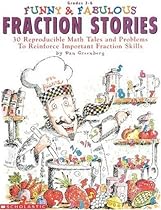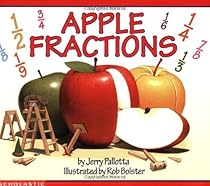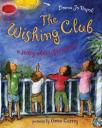Introduction
This instructional resource set has been developed to meet the current Virginia Department of Education’s Standards of Learning (SOL); specifically, third grade mathematics SOL 3.5, 3.6, and 3.11 which cover fractions.

Recommended Fraction Books
1. 
The Hershey’s Milk Chocolate Fractions Book by Jerry Pallotta and illustrated by Rob Bolster
Published in New York, New York by Scholastic Inc.
What a delicious way to get students excited about learning fractions. Even if there may be a limitation on the use of an actual candy bar, the book supplies a reproducible picture of a candy bar. It is wonderful manipulative showing different types of fractions – down to one-twelfth. It is an introductory book that can lead to mixed number fractions, reducing fractions, decimals, and percentages.
2. 
Funny & Fabulous Fractions Stories by Dan Greenberg and illustrated by Rob Bolster
Published in New York, New York by Scholastic Inc.
Everyone loves to laugh and have fun. Why not make a difficult subject interesting. The humorous stories and pictures draw in the students with stories of detectives and adventures (and others) while covering recognizing fractions, reducing fractions, finding equivalent fractions, and adding and subtracting fractions (with like and unlike denominators).
Apple Fractions by Jerry Pallotta and illustrated by Rob Bolster
Published in New York, New York by Scholastic Inc.
This book is a nice departure from the use of a pizzas and one that incorporates learning about some fruits (apples, oranges, and pears) and a small introduction to plant pollination. It begins with a whole apple and progresses through halves, thirds, fourths, fifths, sixths, sevenths, eighths, ninths, and tenths with the help of little elves – emphasizing sharing and equal parts.
Piece=Part=Portion by Scott Gifford and photographs by Shmuel Thaler
Published in New York, New York by Tricycle Press
This is a great book for visual learners beyond the introductory stage. It is the English and Spanish edition. It has wonderful pictures that include the three different ways to write a portion: fraction, decimal, and percent. In this book, the author uses some example involving currency (one-fourth of a dollar).
The Wishing Club by Donna Jo Napoli and illustrated by Anne Curry
Published in New York, New York by Henry Holt and Company LLC
Fractions are learned through problem solving. The children are trying to figure out why they are only receiving a portion of the wish made on a star. Each child wants to receive her or his whole wish. Together, they try to think of wish that will result in a whole thing.
Recommended Web Sites for Students
1. Mini Printable Fraction Books
This website begins with an overview with menu options that run the gammit of fractions. It supplies information from the introductory knowledge and concepts to multiplication and division. However, I choose this web site for the printable worksheets and books.
2. Third Grade Math Practice (see section on Fractions)
A review of fractions is given as the first choice. In total, twelve sections are available to the student to practice their knowledge content and understanding. Use of whole and sets are displayed as a group of items with different colors, geometry shapes with portions in color, and points on a number line. If a question is answered incorrectly, the results will state as such and give an explanation. This is a good simulation of testing a student can use at home or as a work station in class. There is no time constraint and the student can learn at there own pace.
3. 
The Case of the Mysterious Fraction Thieves Web-Quest
I designed this Web Quest to reinforce the contents of the Virginia Department of Education’s Standard of Learning 3.5 Number and Number Sense – Fractions. It begins with the following introduction: There have been several thefts in Whole Town and Part City. The two of you have been assigned as the detectives on the case of The Mysterious Fraction Thieves. You’ll have two days to solve the crime.
This fraction model allows the student to choose between the visual representation of a circle, square, or set. The student can manipulate the slider bar controlling the numerator number and the slider bar controlling the denominator bar. As the numerator and denominator are changed, the portion symbols for fraction, decimal and percent change. The student gets a view of future math knowledge that builds on fractions.
Grampy and Grammy play hide and seek on a number line. The student watches as either Grampy or Gram go hide. One game gives the denominator and asks the student for figure out the numerator by locating Grampy behind a row of hedges. A second game asks the student to find Grammy but asks for both the numerator and denominator. The third games requires the student to take pieces of a cookie (fractions) and make whole cookies for Grampy. The last three games deal with weighing the Gregs (black jelly bean characters). These games deal with grams and decimals. All of the games have helpful hints (too large, too small, hot, cold, higher, or lower) to get the student to right answer.
Additional Resources for Supporting Instruction
1. Math Teaching Ideas – Fractions
This web site gives several of tools for teachers. The site contains worksheets, Smartboard instruction, and games with stated learning objectives.
This web site is organized with clearly written lesson plans. An overview and five lesson plans are detailed out for the teacher. Lesson 1 – Making and Investigating Fraction Strips, Lesson 2 – More Fun with Fraction Strips, Lesson 3 – Investigating Fraction Relationships with Relationship Rods, Lesson 4 – Investigating Equivalent Fractions with Relationship Rods, and Lesson 5 – Inch by Inch. Each lesson plan is organized with learning objectives, materials, instructional plan with illustrations, questions for students, assessment, teacher reflection, NCTM standards and expections.
A Collection of Math Lessons – Grades 1 – 3 by Marilyn Burns and Bonnie Tank
Published in Sausalito, California by Math Solution Publications
Marilyn Burns provides classroom-tested lessons problem-solving approach to teaching. The book contains a vast array of math curriculum for these grades – including fractions. She give examples of actual student work to help teachers recognize where a student’s learning lies and the areas for improvement.
4. Virginia Department of Education Enhanced Scope and Sequence – Grade 3 (Pages 30 – 58)
What better way to devise a lesson plan than going to “the horse’s mouth!” If you do not use what is actually presented in these 28 pages, you will at least know what is expected and have a starting point to create your own lessons and worksheets.




